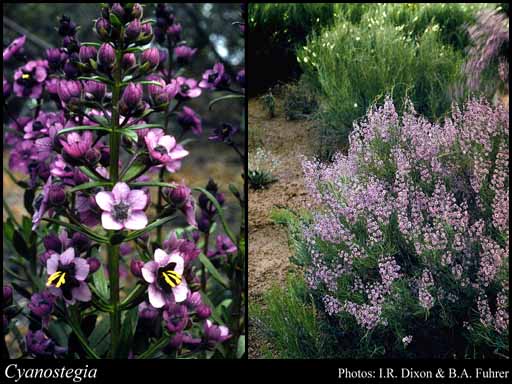- Reference
- Bull.Soc.Imp.Naturalistes Moscou 22(2):35 (1849)
- Name Status
- Current

Scientific Description
Common name. Tinsel Flower. Family Lamiaceae.
Sometimes included in Chloanthaceae, Verbenaceae.
Habit and leaf form. Shrubs; evergreen; without essential oils; resinous (mostly). ‘Normal’ plants to switch-plants (somewhat switch-plant-like, owing to sparse leaves and broom-like habit). Leaves well developed, or much reduced. Plants unarmed. Leaves cauline. Stem internodes solid (woody, terete). To 0.3–2 m high. Leptocaul. Not heterophyllous. Leaves small to medium-sized (gradually reduced to small bracts in the upper floral parts); not fasciculate; opposite; decussate; not decurrent on the stems; ‘herbaceous’; not imbricate; sessile, or petiolate (shortly); aromatic, or without marked odour; simple; epulvinate. Leaf blades entire; flat, or solid; semi-terete; oblong (more or less), or lanceolate, or obovate (sometimes); linear (narrow), or triangular, or elliptic (narrowly), or oblong to elliptic; pinnately veined; cross-venulate. Mature leaf blades glabrous; adaxially glabrous (glutinous); abaxially glabrous. Leaves without stipules. Leaf blade margins dentate; flat. Leaves without a persistent basal meristem. Leaf anatomy. Hairs absent; complex hairs present, or absent. Complex hairs stellate. Stem anatomy. Secondary thickening anomalous; via concentric cambia.
Reproductive type, pollination. Fertile flowers hermaphrodite. Unisexual flowers absent. Plants hermaphrodite. Plants not viviparous; heterostylous.
Inflorescence and flower features. Flowers aggregated in ‘inflorescences’. Inflorescence few-flowered. Flowers not in pairs subtended by a common bract; in cymes. The terminal inflorescence unit cymose. Inflorescences terminal (loose); cymose; cymes arranged in a loose terminal panicle; peduncles axillary. Flowers pedicellate; bracteate; bracteolate. Bracteoles not adnate to the receptacle. Flowers small; very irregular; zygomorphic. The floral asymmetry involving the perianth and involving the androecium. Flowers cyclic; tetracyclic. Free hypanthium absent. Hypogynous disk absent. Perianth with distinct calyx and corolla; 10; 2 -whorled; isomerous. Perianth members entire. Calyx present; 5; 1 -whorled; gamosepalous; blunt-lobed, or toothed (sinuate-); erect; more or less equalling the corolla to exceeding the corolla; broadly, opening flat campanulate; regular; blue, or purple (purplish-blue); non-fleshy; persistent; accrescent. Calyx lobes very widely ovate (membranous, reticulate). Corolla present; 5 (in the upper half, the anterior lobe larger than the other 4); 1 -whorled; gamopetalous; blunt-lobed; imbricate; broadly campanulate (tubular below); unequal but not bilabiate to bilabiate, or regular; hairy abaxially (pubescent-puberulous); glabrous adaxially; plain; deep blue, or purple (dark); non-accrescent. Corolla lobes broadly ovate, or oblong (broadly). Corolla members entire. Androecium 4. Androecial members adnate (epipetalous); markedly unequal; free of one another; 1 -whorled. Androecium exclusively of fertile stamens. Stamens 4. Staminal insertion near the base of the corolla tube. Stamens becoming exserted; didynamous (somewhat); all more or less similar in shape; reduced in number relative to the adjacent perianth; fertile stamens representing the posterior-lateral pair and the anterior-lateral pair; oppositisepalous (inserted near the base of the corolla tube). Filaments glabrous; filiform (in the lower half, almost twice as thick in the upper half). Anthers dorsifixed; dehiscing via longitudinal slits; bilocular (2-lobed, more or less oblong, free in the lower halves). Gynoecium 2 carpelled. The pistil 2 celled. Carpels reduced in number relative to the perianth. Gynoecium syncarpous; synstylovarious (styles free in upper part); superior. Ovary plurilocular; 2 locular. Locules without ‘false septa’. Gynoecium median. Ovary summit hairy, the hairs not confined to radiating bands (mostly warty-corrugate). Gynoecium non-stylate. Styles 1; simple; apical; much longer than the ovary at anthesis; becoming exserted; hairless (glabrous). Stigmas 2; 2 - lobed (minutely and often unequally notched). Placentation axile. Ovules 1–2 per locule; funicled; non-arillate; hemianatropous.
Fruit and seed features. Fruit non-fleshy; indehiscent; a drupe; 4 celled; 4 locular. Dispersal unit the fruit. Fruit 1–2 seeded. Seeds endospermic. Embryo straight.
Special features. Calyx limb 5 lobed. Corolla tube not exceeding the calyx. The upper lip of the corolla incorporating 2 members, the lower 3; (posterior, adaxial) lip of the corolla bilobed; upper (adaxial) lip of the corolla not concave. Lower (abaxial) lip of the corolla 3 lobed; markedly concave. The anterior pair of stamens exceeding the posterior pair.
Geography, cytology, number of species. Native of Australia. Endemic to Australia. Australian states and territories: Western Australia and Northern Territory. Northern Botanical Province, Eremaean Botanical Province, and South-West Botanical Province. A genus of 5 species; 5 species in Western Australia; 4 endemic to Western Australia.
Etymology. From the Greek for "blue" and "roof, tent, covering"; refers to the prominent cup below the calyx.